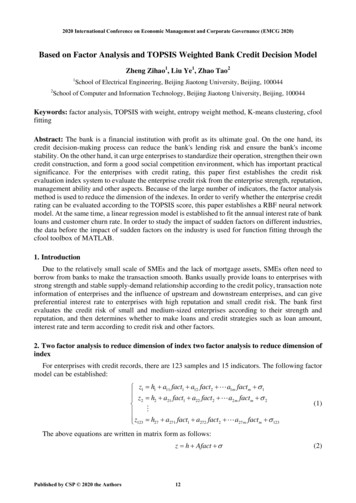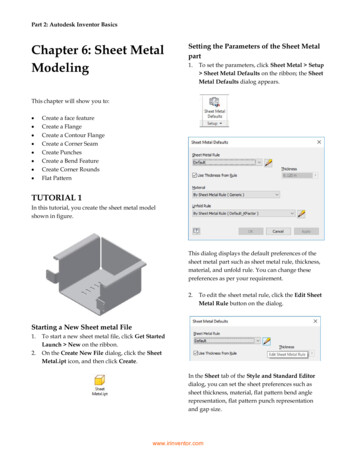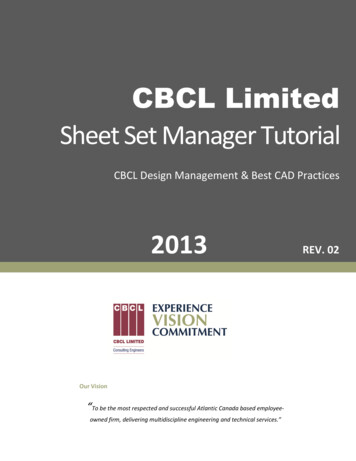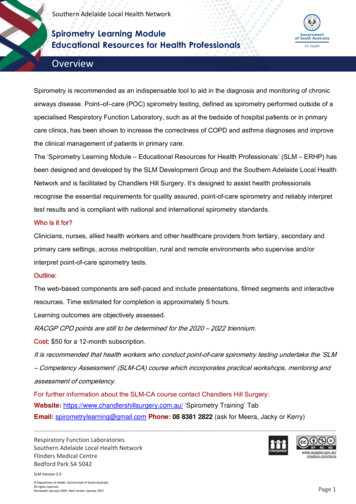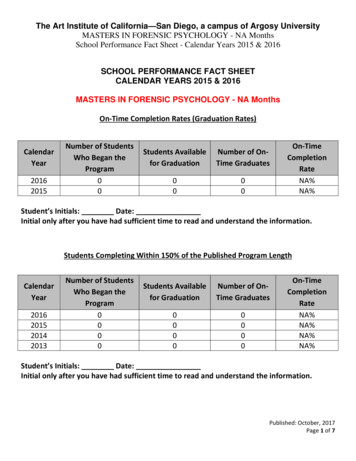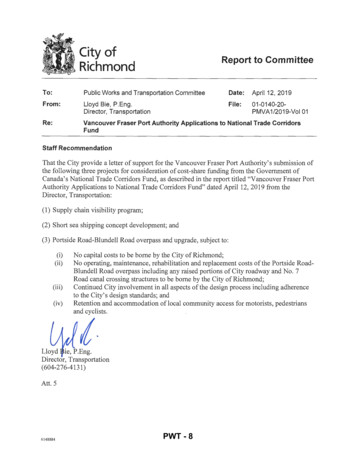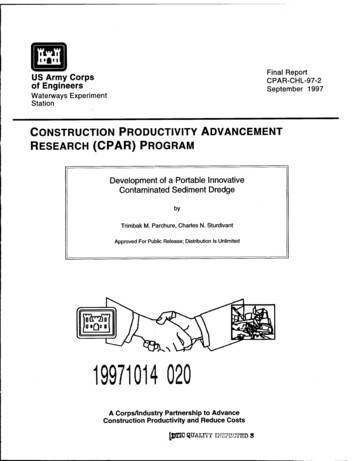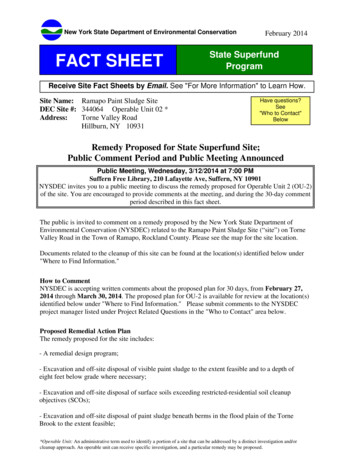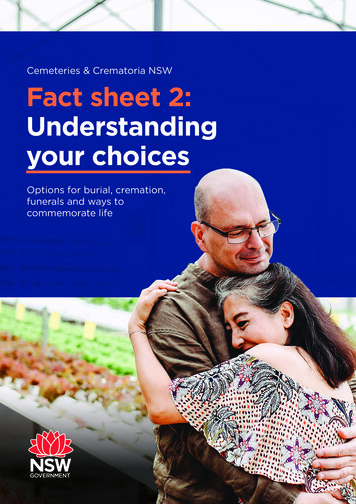
Transcription
Cemeteries & Crematoria NSWFact sheet 2:Understandingyour choicesOptions for burial, cremation,funerals and ways tocommemorate life
ContentsStart planning4Legal responsibilities4Your options for after death4Cremation4Burial (or interment, which can include cremated remains)5Donating bodies to science8Options for being farewelled and remembered8Funerals: a matter of personal preference8At-home funerals (or vigils)9Memorialisation10Published by CCNSW State of New South Wales through Department of Planning, Industry andEnvironment 2020. The information contained in this publication is based on knowledgeand understanding at the time of writing (August 2020). However, because of advancesin knowledge, users are reminded of the need to ensure that the information uponwhich they rely is up to date and to check the currency of the information with theappropriate officer of the Department of Planning, Industry and Environment or theuser’s independent adviser.2 Cemeteries & Crematoria NSW Understanding your choices
Take the time to research and understandwhat your options are, then let family orfriends know your preferred choices andthe way you want to go.Planning for after death allows you to have a say in what happens toyour body and how you are farewelled and remembered. Planningprovides you with an opportunity to reflect on and share the thingsthat are important to you. It will also help your family and friends copeduring a stressful time.In this factsheet, planning for afterdeath means: thinking about and talking with others about our choicesfor burial or cremation planning for a funeral or other ways of beingremembered, including personal and individual touches.Many factors, such as your values, beliefs, personal priorities andfinances, will influence your decisions. NSW is home to more than 200languages groups, over 125 religions, and some 300 ancestries. The richdiversity of our community means there is a wide range of needs whenplanning for after death.Some people may already have specific plans for after death, suchas scattering your ashes at a meaningful location or being buriedsomewhere in particular. For others, this could be the first time you’reconsidering what you’d like to happen to your body after you die.You can make an informed choice about what is right for you byunderstanding your options and discussing them with family andfriends. Some options need to be considered and organised in advance.This factsheet is a starting point. Note that the price and availability ofburial and cremation options will vary.3 Cemeteries & Crematoria NSW Understanding your choices
Start planningIt’s never too early to start planning. Currently many people plan fordeath when they or a relative or friend are close to death. This can putextra strain on a person and their family and friends and may result inpeople making important decisions when under pressure.It is important and helpful to communicate your wishes in advance, sothat your family and friends understand and feel able to follow throughwith them when the time comes.We have prepared a useful factsheet and checklist to help you takethose first planning steps.Legal responsibilitiesBurying or cremating a deceased person is compulsory in NSW. ThePublic Health Act 2010 and Public Health Regulation 2012 regulatesthe handling of bodies both by funeral industry professionals and bymembers of the public. The regulation provides rules for preparing,transporting and disposing of bodies.Your options forafter deathIn NSW, you have the option of cremation or burial. There are around380 operators who provide burial or cremation services across NSW.CremationTwo out of three people who die in NSW each year are cremated.Cremation is often chosen because of its simplicity and is generallycheaper than burial, partly due to using less space.Understanding terminologyYou can choose between a ‘regular’ cremation or a direct cremation. A cremation is usually packaged with a funeral ceremony of yourchoice. A direct cremation does not include a funeral ceremony at thetime and location of the cremation. It may also be referred to asa ‘no-service cremation’, or as ‘cremation only’. This can meanfamily and friends do not attend the cremation but can still arrangea ceremony prior or a memorial at another venue later, if theychoose.4 Cemeteries & Crematoria NSW Understanding your choices
Understanding costCompared to burial, cremation can be asignificantly cheaper option. In 2019, AustralianSeniors undertook research to understand theaverage cost of death in Australia. A standardcremation (with funeral ceremony) costs onaverage 5,600. Australian Seniors estimatesthe average standard cremation with ceremonyin NSW ranges from around 4,900 in nonmetropolitan Sydney to 6,200 in metropolitanSydney.Further information about cost is availablein Cemeteries & Crematoria NSW’s Generalconsumer guide to interment rights in NSW.Choosing a coffinThe NSW Public Health Regulation 2012 requiresall cremations, including direct cremations, usea coffin. There is a range of coffin materials andprice points. If you prefer, you can choose a coffinthat is environmentally friendly and/or one withcustomisable design features.While options vary between providers, thereis nothing stopping you from asking for acoffin made from ornate rosewood, mahogany,cardboard, particleboard, wool or wicker. You canresearch in advance which materials best suit yourneeds and budget and discuss this with a funeraldirector or crematorium operator.Transporting and scattering ashesScattering ashes in a place that has meaning forthe person who died can happen in NSW. Aroundone-third of people have their ashes buried orscattered at a cemetery.1 You will need to seekpermission to scatter ashes on private land thatyou do not own and may need to seek permissionfor public places such as parks, beaches or playingfields. Your funeral director or local council canadvise you.with local requirements. The ashes will need tobe transported in a sealed urn or container inhand luggage, with a copy of the death certificateand a copy of a statement from the crematoriumidentifying the deceased person, noting whereand when the body was cremated.Further information—cremation guideCemeteries & Crematoria NSW’s quick guide oncremation is available online.Burial (or interment, whichcan include crematedremains)Burial of human remains—including crematedremains—can be either directly in the groundor above ground in a mausoleum, vault,columbarium, niche wall or other structuredesigned for this purpose. This is known asinterment.Burial is highly important for many cultures andreligious groups. Around one-third of people inNSW choose to be buried.Understanding terminologyAn interment right is a contract with a cemeteryoperator that allows interment to take place ina particular location in a cemetery. The right ispurchased, and the holder of the interment right isthe only person able to choose who can be buriedat the site.In NSW there are two types of interment rights: Perpetual interment rights allow for remainsto be left in place forever. Renewable interment rights allow forremains to be left in place for a limited period,between 25 and 99 years.In Australia, it is legal to take cremated ashesoverseas. You must contact the consulate of thecountry you are visiting ahead of time and comply1 www.industry.nsw.gov.au/ data/assets/pdf -19.pdf5 Cemeteries & Crematoria NSW Understanding your choices
Understanding costThe high cost of burial in Australia’s capital citiesis driven by a shortage of land set aside for burial,as well as by the cost of cemetery maintenance.In 2019, Australian Seniors undertook research tounderstand the average cost of death in Australia.The average cost for a standard burial and funeralin Australia is around 9,400. The average for astandard burial and funeral in NSW ranges from 7,900 in non-metropolitan Sydney to 16,200 inmetropolitan Sydney.Further information is available in Cemeteries &Crematoria NSW’s General consumer guide tointerment rights in NSW.CemeteriesCemeteries play a pivotal role in ourcommunities, offering a place for remembranceand reflection as well as providing open spacesin our cities and towns.Many modern cemeteries also provide recreationalareas for walking and cycling, sculpture gardens,spaces for reflection, meeting places andcommunity facilities such as cafés. Burial plots areoften provided in rows within a manicured lawnarea and memorials and plaques are minimal.Natural burialA ‘green’ sustainable or natural burial meansreturning human remains as directly aspossible to the earth in grounds that minimiseenvironmental impact.Natural burials usually involve burying a bodythat isn’t embalmed in a biodegradable vessel orshroud. This process reduces the environmentalimpact of burial because fewer chemicals fromcoffins, synthetic clothes and embalming fluidsdrain into the soil.Rather than placing a headstone or plaque, familyand friends can locate the burial location usingGPS technology. There is usually no physicalmemorialisation or clear visual marking. Somenatural burial sites allow a rock or natural marker.Natural burial sites are currently available inmetropolitan Sydney, Lake Macquarie, Lismoreand the Southern Highlands. Over time, we expectmore natural burial sites will be approved.While natural burials offer opportunities to limitthe environmental impact of conventional burial,they commonly also limit the opportunity forphysical memorialisation.For further information, Cemeteries & CrematoriaNSW’s quick guide on natural burial is availableonline.Reusing burial spaceIn NSW, burial lots can be purchased: in perpetuity—meaning forever as renewable interment for between 25 and 99years.At the end of a renewable interment right, theremains are to be removed and placed in anossuary box and reburied in the same grave orplaced in an ossuary house.2 The grave, crypt orniche can then be reused.Renewable interment rights were made availablein NSW in 2018 to help address the land shortagefor cemeteries in urban areas.It is not mandatory for a cemetery to providerenewable interment rights and consumers donot need to choose this option.Natural burials are commonly done in a cemeteryin a bushland setting—at times some distancefrom urban areas—that is at a natural burial site orprivate land that has been approved. The naturallandscape is left as undisturbed as possible.2 An ossuary box is a container that serves as the final resting place for human remains.An ossuary house is a building that serves as the final resting place for human remains.6 Cemeteries & Crematoria NSW Understanding your choices
Multiple grave occupancyMultiple occupancy graves allow family membersto be buried close together, which manyfamilies find comforting. It can also facilitatememorialisation and make it easier for relativesand friends to visit the graves of multiple familymembers.This method of burial can also alleviate spaceissues. The proportion of families opting formultiple occupancy is reportedly growing in NSW,though numbers remain small.Further information is available in Cemeteries &Crematoria NSW’s General consumer guide tointerment rights in NSW.Sustainable coffins, shroudsand urnsMaterials used to produce conventional coffinsinclude timber, varnishes, plastics, metaland fabrics. Many of these materials are notbiodegradable and may remain in the soil fordecades, even centuries. Growing numbersof NSW consumers and families are seekingenvironmentally conscious options that matchtheir values and preferences.If you are seeking environmentally sustainableoptions, the following are increasingly available,can be used at conventional cemeteries, and canbe discussed with your funeral director: caskets made of willow, wicker or wool cardboard coffins, which can come withcustomisable designs biodegradable scattering tubes, earth urns,corn starch urns or salt urns burial shrouds made from biodegradablematerial such as 100% cotton, bamboo, linenor wool biodegradable burial suits made frommushrooms and other micro-organisms.Steps required in NSW to beburied in a shroudA shroud is a length of cloth used to wrap a bodyin preparation for burial or cremation. Shroudsare usually made of an organic material, such ascotton, linen or wool.In NSW, you are required to use a casket or coffinfor burial or cremation. However, you can apply tobe buried in a shroud on both religious and nonreligious grounds. Most people seeking burial ina shroud will need to complete a burial of a bodynot placed in a coffin exemption form to gainpermission from NSW Health.You can request the use of a shroud in advanceof death, or a family member, community group,funeral director or cemetery provider cancomplete the form on your behalf. You need tomake arrangements with the relevant cemeterybeforehand and use a watertight vessel whenmoving the body.Funeral directors and cemetery operators canhelp you develop your shrouded burial plans.Getting buried in a natural or green cemetery maybe a simpler process if shrouded burial is yourpersonal preference, but it’s not necessarily moreaffordable.At-home burialsYou can apply to your local council to be buriedon private property, which may be your propertyor that of someone you know. In NSW, theproperty must be greater than five hectares, andthere must be no risk of contaminating drinkingwater.The body must be buried in a securely sealedcoffin at a minimum depth of 90 centimetresclearance below the natural surface depth of thesoil (a geotechnical investigation might be neededto identify issues such as depth of the watertable).Further information is available in Cemeteries &Crematoria NSW’s General consumer guide tointerment rights in NSW.7 Cemeteries & Crematoria NSW Understanding your choices
Donating bodies to scienceDonation of your body to science must be arranged prior to death. It isnot something next-of-kin can opt to do after-death. Universities usebodies for research and education. Learn more about what happensto your body if you donate it to science through our ‘Did You Know’factsheet, which contains interesting facts and answers to frequentlyasked questions.The Australian Facility for Taphonomic Experimental Research is aunique body donation facility located in the Blue Mountains dedicatedto the study of human decomposition. The research is used to assistpolice and forensic investigators to search for, locate, recover andidentify victim remains.If you want to donate your organs after death, you can find informationon the NSW Government’s Life Events website under Make a healthcare plan. ptions for beingOfarewelled and rememberedFunerals: a matter of personal preferenceA funeral is a ceremony celebrating or remembering a person’s life andcan be a critical step to process grief. Funerals can provide importantsupport in a time of loss by bringing family and friends together tofarewell the deceased person. Usually the funeral is prior to burial orcremation, with the coffin present.You can have a funeral that is traditional or unique. It can adhere to yourvalues, beliefs or cultural requirements, your interests or your specificrequests. You can call it a gathering, a service, a ceremony, a send-off ora life celebration.A funeral does not have to include a religious ceremony. Some peoplechoose to hold the funeral ceremony at time or place other than beforethe cremation or burial, or even choose not to have a ceremony at all.A funeral director can provide a complete funeral, including: organising the cremation or burialproviding a choice of coffins or shroudslooking after the deceased’s bodyarranging transportation, flowers, music, legal paperworkproviding comfort for families.8 Cemeteries & Crematoria NSW Understanding your choices
While there is no legal requirement to havea funeral or to use a funeral director, manypeople do find it easier to have an experiencedprofessional lead and support them through theprocess. Research commissioned by Cemeteries& Crematoria NSW indicates that two in threepeople in NSW would consult a funeral directorwhen planning for after-death.DIY funerals, in which families undertake manytasks that would typically be the duty of thefuneral director, constitute a small but growingnumber. Some families opt for a mix of DIYand a funeral director. This can help reduce theoverall cost of a funeral as well as provide amore personalised funeral and closer sense ofinvolvement.There are no set fees for funerals in NSWand costs vary depending on the cemetery,crematorium, venue, scope of event and thelevel of service provided by the funeral directoryou work with. There are many options availablewhen it comes to planning a funeral. AustralianConsumer Law guarantees your rights when youpurchase goods and services for funerals.For further information about funerals, visit theNSW Government’s end-of-life planning webpage.At-home funerals (or vigils)In Australia and internationally, a growing numberof people are involved in continuing home care oftheir relative or friend after their death. In NSW,if a person has died at home it is possible for thebody to stay at home for up to five days before itis transferred into the care of the funeral director.It is important to make plans for this option beforethe person has died. Prior to a person’s death, anexperienced director can advise or help you hirecooling plates, or even pack the body in ice, toallow for a vigil.Once notified, the treating doctor will issue aMedical Certificate Cause of Death. In somecircumstances the body may need to go to thecoroner to explore the cause of death.Given it is challenging to arrange thetransportation and burial or cremation of a body,you will generally need to engage an experiencedfuneral director for support with these activities,even if holding an at-home funeral. An increasingnumber of community funeral directors, somewith death doula services, are emerging to helppeople with after-death home care and to hold afuneral at home.9 Cemeteries & Crematoria NSW Understanding your choices
MemorialisationThe sky’s the limitA memorial acknowledges a life and is a focalpoint for reflection. Memorials can be createdfor individuals, families or for specific groups(such as veterans).Several companies are developing softwareapplications (apps) to tell life stories from thegraveside. Some companies will make a small discto attach to a grave or a memorial site, and theinformation is relayed via Bluetooth technologyto an app on your phone so a loved one canscroll through photos and listen to the person’sfavourite music and voice recordings.In recent years, interest has grown in morepersonalised services, events and memorials thatreflect the values of the person’s life and theircommunity. Your funeral director or cemetery/crematorium operator can advise you.Your possibilities for memorialisation are nearlimitless. You may want to ask yourself:Do I want a permanent memorial place wherefamily members and friends can visit?Do other family members want to keep someremains? There is no rule that ashes must be kepttogether. They can be divided between people orfor different purposes.Some websites offer templates for creating onlinememorials. Some are free and others have pricingplans or one-off fees—which allow users to createpersonalised online memorials for loved ones.There are several companies offering creativethings to do with loved ones’ ashes. In Australia,some companies offer to create jewelled urns,fireworks and artworks from cremated ashes.It is common for memorialisation to include aplaque or headstone. Memorialisation can takeplace within a wide range of formats including: within gardens or lawns, around trees orpathways memorial seats or trees within scattering areas, with or without somevisible record of names sculptures and artworks using portions of cremated remains withinkeepsake jewellery or artworks using public spaces with permission fromthe landowner, for example jetties, parks,grandstands, municipal gardens or roadnames.10 Cemeteries & Crematoria NSW Understanding your choices
Cemeteries & Crematoria NSW (CCNSW) is the part of NSWGovernment that regulates cemetery and crematoriumoperators and provides information on burial and cremationoptions to the public. Its objectives are to ensure thateveryone in NSW has the right to a dignified burial orcremation that is respectful of religious and cultural beliefs.CCNSW also holds a critical role in ensuring land is availablefor affordable and accessible burial and cremation options inNSW, now and in the future.www.dpie.nsw.gov.au/ccnsw11 Cemeteries & Crematoria NSW Understanding your choices
5 Cemeteries & Crematoria NSW Understanding your choices Understanding cost Compared to burial, cremation can be a significantly cheaper option. In 2019, Australian Seniors undertook research to understand the average cost of death in Australia. A standard cremation (with funeral ceremony) costs on average 5,600. Australian Seniors estimates

